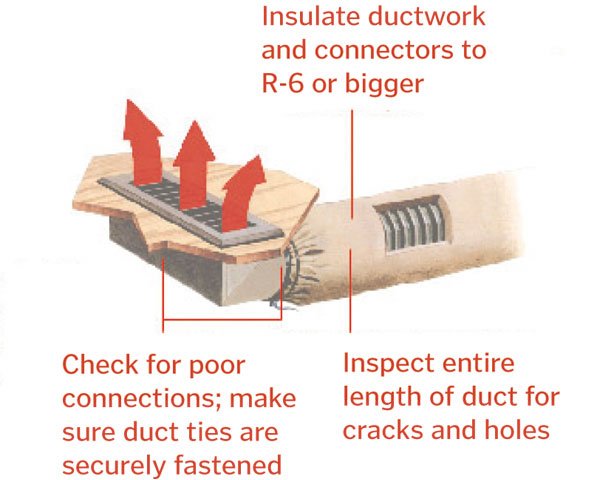No, it doesn’t get engine-block cracking,
dig-your-way-out-the-front-door cold here in the South Valley. But
when winter hits, our homes can still become money pits when it
comes to the energy bill if we don’t take certain steps to prepare
for the onset of the heating season.
No, it doesn’t get engine-block cracking, dig-your-way-out-the-front-door cold here in the South Valley. But when winter hits, our homes can still become money pits when it comes to the energy bill if we don’t take certain steps to prepare for the onset of the heating season.
There are quick and inexpensive ways to save money on your heating bill this winter, there are more costly measures you can take … and then there are the really radical steps some adventurous souls will be interested in, which involve going with a photovoltaic or wind-electric system (or a combination of both) that allows you to generate your own power for your house, and get off the power company’s grid completely.
“In terms of thermal loads, you’re up against two actors,” says Richard Perez, the publisher of Ashland, Ore.-based Home Power magazine (www.homepower.com). “First, what’s your heat source? Are you on natural gas or electric? Second, how well do you keep that heat in your living space? In other words, how well insulated is your home?”
Perez who has “been living and working off-grid since 1970” in a home powered by solar cells and wind in the mountains above Ashland, says most folks aren’t going to be able to do much about their home’s heat source unless they really want to spend some money. Retro-fitting existing homes is possible, he says, but most people who want an off-grid house or even just a hybrid – some combination of self-made power and purchased power – are going to wind up building a new one.
When it comes to shoring up your insulation, Perez says that too can be expensive, but there are some easy and cheap ways to make life warmer for less during the winter.
Here’s a look at the gamut of options for making your home more energy-efficient when the temperature falls:
QUICK AND CHEAP FIXES
PG&E’s Web site (www.pge.com) offers a bunch of common-sense tips for spending less on heating in the winter. You should be able to do most of these things yourself; if you need to hire a professional, some suggestions will be more expensive to implement. Here are some quick and cheap fixes, courtesy of your friendly neighborhood energy monopoly:
n In the heating season, set your thermostat at 68 degrees or lower during the day, health permitting. Keep warm indoors by wearing warm clothing, especially several light-weight layers. Savings: 5 percent to 10 percent of space heating costs.
n Install a programmable thermostat to change thermostat settings automatically at certain times of the day, based on heating needs. For example, set your clock thermostat at 55 degrees or off for the night and 68 degrees for the time right before you awake. For every degree you lower your heat in the 60-degree to 70-degree range, you’ll save up to 5 percent on heating costs. Savings: 5 percent to 20 percent of space heating costs.
• Plug gaps around pipes, ducts, fans and vents that go through walls, ceilings and floors from heated to unheated spaces. Savings: 1 percent to 3 percent of space heating costs.
• Keep your furnace clean, lubricated and properly adjusted. Clean or replace the filter regularly. Dirty filters reduce air flow and make your furnace work harder. Savings: Up to 5 percent of space heating costs.
• Turn your heater(s) down when you’re using your fireplace. Don’t forget to close the damper when you’re not using the
fireplace. Savings: 2 percent to 8 percent of space
heating costs.
• Use passive solar heating on sunny days. Open the drapes on windows facing south to let the sun shine in. Then at night, close the drapes to retain indoor heat. If you have a large expanse of glass that doesn’t receive direct sun, keep the drapes closed. Up to 16 percent of your heat can escape through unprotected windows.
Home Power’s Perez concurs with PG&E’s advice, and adds a few quick fixes of his own:
• Put in a timer on your hot water heater, as well as on the air heater.
• Purchase an electric hot water heater jacket.
• If you’ve got a shed or other space outside of your home’s thermal envelope, and if its cool enough, put refrigerated goods in that space during the winter. You can also put your refrigerator(s) in the space – you’ll spend less on refrigeration because the appliance isn’t fighting the heat in your home to cool things down.
• Replace incandescent lights with compound fluorescents – actually an energy-saving measure you can do all year round.
NOT-SO-QUICK OR
CHEAP FIXES
These energy-saving measures can cost in the hundreds to the thousands of dollars. They involve more intensive ways to beef up your home’s insulation – fairly inexpensive if you can do it yourself, but if you need a professional to do it for you, the costs can run up quickly.
From PG&E:
• Have your ducts tested for air leakage. Leaking ducts can reduce the efficiency of your heating system by up to 30 percent. Seal leaks with mastic or non-cloth backed tape labeled UL181 B-FX.
• You can cut your heating costs up to 25 percent simply by installing proper ceiling insulation to at least R-30 standards. Insulate walls, floors and heating ducts. This insulation will not only keep heat from escaping, but will also
make your home more
comfortable.
• By caulking and weather-stripping, you can cut your heating bills up to 10 percent. Weather-strip doors and windows, and caulk air leaks around windows, door frames and ducts. For DIYers, a good way to check for drafts is to light an incense stick and hold it outside the window in question. Note where
the smoke curls up and into the house.
• Use insulating shutters or drapes and keep them closed during winter nights and summer days. Savings: 8 percent to 15 percent of space heating costs.
From Perez:
• Replace windows with double- or even triple-paned glass. This can be expensive and it may take several heating seasons before you get your investment back on your energy savings.
• Install a solar water heater. It can cost from $500 to several thousand dollars. California offers tax credits when you go solar, so it’s definitely worth investigating.
• At the very high end of not-quite-radical steps you can take, is to purchase a factory-made sunroom. These units are available from several companies in California. They generally feature glassing from the ground up over the eaves, or are completely made of glass, like a greenhouse. The unit is attached to the south side of your house, where it can convert the most sunlight into heat during the winter. You can install blowers to move the heat generated in the sunroom to other parts of the house. Units cost from $10,000 to $20,000.
THE RADICAL
The 2,800-sq.-ft. home where Perez lives with his wife Karen is insulated well beyond code, employs passive and active solar heating, and wind power, and retains heat throughout the winter thanks to tubes embedded in the slab that fill with water from the solar heating system. These take two to three days to warm up, and three to four days to cool down, according to Perez.
The building is oriented to face the sun, with lots of windows on the south face generating heat – passive solar power – and solar cells on the roof – active solar power.
The Perezes live completely off the grid, meaning their yearly power bill is a nice, neat $0.00.
Obviously, this is a big step to take. Many homeowners aren’t going to be able to generate enough power to go off the grid themselves, Perez says, mainly because a self-powered house usually has to be built with that intention from the get-go. Retro-fitting is expensive and may not produce the maximum results, particularly if the house isn’t positioned to take best advantage of the prevailing sunlight.
Of course, if you’re planning on building a house, it can’t hurt to investigate making it self-powered.
Meanwhile, Perez notes, many people living in self-powered homes don’t go off the grid, as he has. California is one of 38 states with net metering legislation that requires the power company to buy any surplus
electricity you produce and offer for sale.
How cool would that be – watching your meter actually run backwards and getting a check every month from the power company?
Resources
Web sites with Energy-Saving Tips:
The Alliance to Save Energy: www.ase.org
Promotes energy efficiency to achieve a healthier economy, a cleaner environment and energy security.
The American Council for an Energy-Efficient Economy: www.aceee.org
Non-profit organization dedicated to advancing energy efficiency as a means of promoting both economic prosperity and environmental protection.
The American Solar Energy Society: www.ases.org
Promotes the widespread near-term and long-term use of solar energy.
The American Wind Energy Association: www.awea.org
Promotes wind energy as a reliable, environmentally superior energy alternative.
The Green Power Network: www.eere.energy.gov/greenpower
Information about Green Power purchasing and programs around the country.
Home Power: www.homepower.com
Hands-on journal of home-made power.














